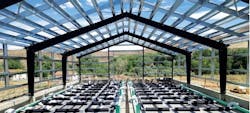About the author: Dirk Fischbach is communications liaison for RJ Conlin Marketing & Design. Fischbach can be reached at [email protected] or 734.417.1006.
When most people think of storm water management, they envision large precipitation events and a need to control heavy amounts of runoff. However, there is another side to the coin that is just as critical: gathering and protecting rainwater in areas where precipitation is sparse and water resources are jealously guarded.
It is in this environment that the Evans Greenhouse project arose. Based 30 miles outside Reno, Nev., in Wadsworth Township, Evans Greenhouse will implement technologies to harvest and reuse rainwater to support a plant nursery and local firefighting needs.
“This area only gets 7 in. of rainwater a year, so we are trying to capture everything we can from the hardscape to be recycled and used to support irrigation and to build water reserves for the local fire department," said Jonas Sippala, project manager.
“Instead of using the Triton chambers for underground dispersal, we lined the bottom of the trench with an impervious EPDM [ethylene propylene diene monomer] liner,” Sippala said. “When water runs off the hard surfaces, it is sent through a filter before going into the chambers for storage. We created two risers that are fed by the stored water. One of the risers is reserved for the fire department, and one riser is used to irrigate the greenhouse plants.”
The system utilizes a 12-V solar-powered pump to move the water, and the risers can be filled from underground wells during insufficient rainfall periods to meet the needs of the fire department or greenhouse.
Along with the Triton chambers, the system uses Environmental Passive Integrated Chamber (EPIC) technology developed by Firestone Water Management. The EPIC system utilizes a sand layer, which serves as a growing medium for plants, above the storage chambers to prefilter water as it enters the storage field.
A gravity filter and drip collection option will serve as further pretreatment sources for the water as it enters the Triton chambers.
“There is no soil absorption with the system,” Sippala said. “Everything is utilized by the plants or returned to storage.”
A Sustainable Future
The current project, which includes the 4,000-sq-ft greenhouse and a 6,000-gal reservoir, is a prelude to bigger things to come—in the fall, construction will begin on a 44,000-sq-ft greenhouse that will utilize the same technologies. Project engineers estimate that the current system will return 17,360 gal of water from the 7 in. of rainfall the area averages—an important reuse of this vital resource.
Sippala said that the chambers fit the needs of the EPIC system and the Evans Greenhouse project.
“I was familiar with the various options we had in underground storage,” he said. “The chambers offered a number of advantages—they stack well for transport, they are easy to install, they have good dimensions and they offer linear storage, which was important for the greenhouse project. The soy resin construction was also a bonus, as it is in harmony with the sustainable, low-impact model that guided the project.”
Once the area was prepared, the installation of the two long rows of chambers took less than half a day, and required no special machinery.
“One of the things that many project managers comment on is the speed and ease with which the system can be installed,” said Joe Miskovich, Triton founder and president. “The chamber design lends itself to easy alignment and placement, and installations can typically be done in a matter of hours.”
The system often is utilized in areas where the terrain or existing infrastructure create design challenges. Modular in design and simple to work with, the chambers can be configured in any number of ways to fit odd-shaped storage areas, and are strong enough to be used in a double-stacked orientation where maximum storage with a minimal footprint is required. They have been used in several “model” projects, where developers wanted to showcase green technologies, sustainable land use patterns, low impact development and LEED credit potential.
While the Evans Greenhouse project used an impervious liner to support rainwater harvesting, a more typical scenario calls for the chambers to store runoff while it gradually leaches back into the water table, replicating the natural hydrologic process.
“The driving concept behind the development of Triton Stormwater Solutions was to give professional managers and developers a tool that they could use to support their project, regardless of the storm water management needs,” Miskovich said. “Projects like the Evans Greenhouse are especially gratifying because they demonstrate an unconventional use of the chambers. We often say that the design of a Triton chamber-based system is limited only by the imagination of the designer—and projects like this demonstrate that in a very real way.”
Download: Here


